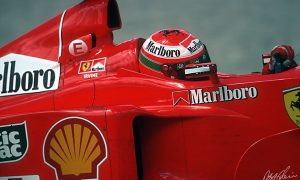The 2016-spec Ferrari challenger slightly differs from its predecessor, both from the outside and the inside. Let’s take a look under the skin of the SF16-H thanks to Nicolas Carpentiers’ images and explanations.

©F1i
FERRARI’S UNIQUE COOLING SYSTEM
Cooling the turbocharged air on the Ferrari 059/5 power unit follows a two-fold process. Before entering the engine, the air travels through a triangular air-to-air radiator located above the gearbox. The device is mounted vertically on the Ferrari SF16-H and Haas VF-16, while it sits horizontally on the Sauber C35.
The air is then channelled to a second cooler via a big duct on the left-hand side of the unit, which features a characteristic blue-coloured seal. Sporting a rectangular shape, this second radiator is slightly tilted and attached to the front of the engine. When the plant is fitted to the chassis, the cooler slots into the monocoque itself. The Mercedes W07’s single intercooler occupies a similar position, though it sits at a lower level.
Ferrari’s two-pronged cooling setup led the Maranello engine engineers to design a slimmer oil tank that has been moved to the right-hand side in order to free up the required space for the second intercooler.”
Ferrari has gone for a two-step cooling setup in order to clear the sidepods as much as possible and limit airflow resistance.
This two-step cooling installation replaced the single intercooler that was lodged within the ‘Vee’ of the engine on the 2015-spec Ferrari engine (see bottom left picture; one can spot the intercooler’s blue pipe collar). Why did the Scuderia go for such a sophisticated and complex setup? Although having the intercooler slotted in between the two banks of cylinders offered a tight package overall, it did not allow for the variable inlet trumpets seen on all other V6 turbos last year.
In the end, the intercooler had to be placed somewhere else. Maranello could have moved it in the sidepods, either as a single element like on the McLaren or by using the split-intercooler design seen at Red Bull. Finally, the Ferrari engineers have decided to use a double installation in order to clear the sidepods as much as possible and limit airflow resistance.
On the image above, one can also notice the singular shape of the air filter, the engine mounting points (their positioning is mandated by the F1 technical regulations), as well as the numerous cooling or high-pressure hydraulic ducts.






